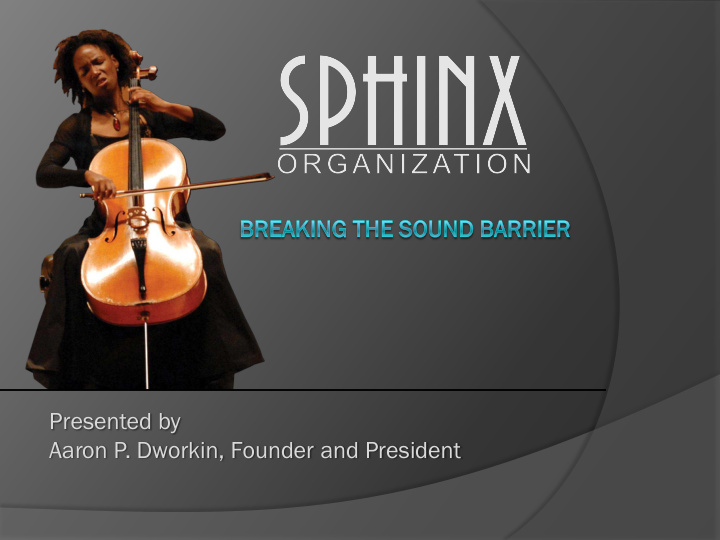



Presented by Aaron P. Dworkin, Founder and President
Randall Goosby, age 13 Winning Performance of the 2010 Sphinx Competition With the Sphinx Symphony Orchestra, Maestro Anthony Elliott
“T he e de deep epes est de defea eat suffer ered ed by hum uman an bei eing ngs is is c cons nstit itut uted ed by the e di differ eren ence ce bet etwee een what one w e was capa pable e of bec ecomin oming g an and w d what at one ne has as in in fact become.” - Ashley y Montagu gu
Pic of Hershey parents and bro
Pic of Hershey parents and bro
Pic of birth parents
Pic of sis
Cool montage birth and adoptive families
Courtesy of Interlochen
Diversity State of the Field Orchestras Regular Positions Held by Minorities in American Orchestras Blacks 1.83% Hispanics 2.42% Asians 7.34% Whites 88.41% Minority Representation in Orchestras and in the National Population 15% 15.4% 12.8% 10% 7.34% 4.5% 5% 2.42% 1.83% 0% Black Latino Asian American Representation in US Population Representation in Orchestras
Diversity State of the Field Orchestras Positions held by Minorities Executive Directors in American Orchestras Blacks 0.4% Music Directors/Conductors Hispanics 0.8% Other 2% Whites 96.8% Blacks 2.3% Hispanics 1.8% Other 8.6% Whites 87.3% Education and Community Relations Directors Blacks 3% Artistic Administrators Hispanics 2.2% Other 3% Whites 91.1% Blacks 0% Hispanics 0% Other 0% Whites 100%
Diversity State of the Field Orchestras Programming Top Ten Most Frequently Performed US/Canadian Composers Overall Top Ten Composers Blacks 0% Hispanics 0% Other 0% Blacks 0% Whites 100% Hispanics 0% Other 0% Whites 100% Programming Milestone? Minorities 1% Whites 100%
Diversity State of the Field Music Schools Master’s Specific Blacks 3.8% BA Professional Hispanics 3.9% Other 8.9% Blacks 6.7% Whites 83.4% Hispanics 5.2% Other 3.4% Whites 84.7% Total Faculty Blacks 4.8% Hispanics 2.7% Total Doctoral Other 3% Whites 89.5% Blacks 2.5% Hispanics 5.3% Other 17.4% Whites 74.8%
Diversity State of the Field Youth Orchestras Minority Representation in Youth Orchestras Blacks 3.5% Hispanics 4% Other 17.5% Whites 75% Minority Representation in Youth Orchestras and in the National Population 17.5% 20% 15.4% 12.8% 15% 10% 4.5% 4.0% 3.5% 5% 0% Black Latino Other Representation in US Population Representation in Music Schools
Diversity State of the Field Audience Demographics Classical Music Audience Projection 2008-2018 (Simmons Data) Millions of People Blacks 4% Hispanics 6% Other 5% Whites 85% Source: 2008 NEA Survey of Public Participation in the Arts Total Loss of Audience: 14% or 3 million Over 80% of losses are among Whites
Diversity State of the Field Audience Demographics Hispanic Classical Music Audience Projection 2008-2018 Millions of People Total Growth: 46% or over 1 million Non-White minorities will drive the VAST MAJORITY of new gains in classical music audiences Source: 2009 League of American Orchestras, Audience Demographic Research Review
Sphinx Overview Video
U.S. Public Support of the Arts Per Capita Spending on 2009 Arts & Culture Funding Arts & Culture 12 2% $11B 2% 10 8 BILLIONS 1% 1% 6 .8% 4 2 $680M .005% $155M 0 Population of U.S. is 300 Million. Population of City of Berlin is 3.5 Million.
Role of Music in Society Beginning at an early age: cartoons Television shows and movie soundtracks Many popular music celebrities had classical training: Alicia Keys Tupac Shakur Tori Amos Beyoncé Boyd Tinsley (Dave Matthews Band violinist) Aretha Franklin Erykah Badu Boys II Men
Music in Social Movements Civil Rights Movement Martin Luther King Frederick Douglass Cesar Chavez Civil War French Revolution
Impact of Music Education Advanced Degrees/Income 100% 88% 83% Music Participation 80% Music Education 60% 40% 20% 0% 2008 SAT Scores English/Math Scores 537 19% 540 528 20% 17% 530 519 515 520 15% Reading 510 502 10% 494 Math 500 English 490 Writing 5% Math 480 0% 470 % higher than No Studied schools with Arts/Music Arts/Music no music program
Decline of Arts Education Students, ages 18 to 24, reporting having taken at least one arts class during their life: 60% 58% 60% 51% 47% 50% 40% 1982 28% 26% 30% 2008 20% 10% 0% White Black Latino Source: President's Committee on the Arts and Humanities; Reinvesting in Arts Education; 2011
Sphinx Impact - First 10 Years America’s Top Orchestras 2.4% 2.50% All orchestras with an increase in 2.00% Black members had a relationship with Sphinx 1.50% 1.16% % of Blacks 1.00% 0.50% Source: League of American Orchestras 0.00% 1998 2008 Prior to Sphinx: Solo performances by musicians of color were rare: now 20-30 per year No professional Black & Latino orchestra existed: Sphinx has 2 Never in history, Black & Latino orchestra on tour: now every year Very rare to see or hear classical music performed by musicians of color: now over 2 million in audiences every year Relatively few commissions by composers of color: now increasing every year Sphinx Alumni graduated to every top 10 music school First intensive summer training program for Black & Latino string players 85,000 students reached in over 200 schools Nearly $1.5 million in scholarship awards
Sphinx Impact - First 10 Years Just the beginning… …much work needs to be done
“ Change does not roll in on the wheels of inevitability, but comes through continuous struggle. History will have to record that the greatest tragedy of this period was not the strident clamor of the bad people, but the appalling silence of the good people. Our lives begin to end the day we become silent about things that matter. ” - Martin Luther King, Jr .
Building Diversity in Classical Music
Recommend
More recommend